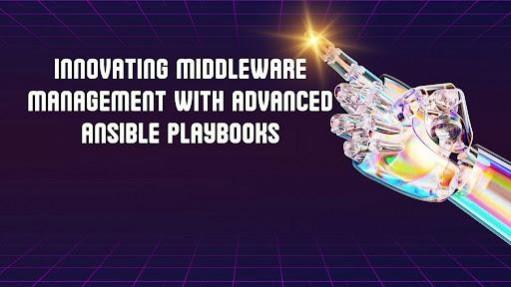
In an era where IT infrastructure is growing in complexity, automation has become the key to efficiency.Pramod Muppala explores groundbreaking advancements in Ansible playbooks that are transforming middleware management.
The Shift Towards Automation
Traditional middleware management relied heavily on manual interventions, leading to inconsistencies and inefficiencies. Organizations faced difficulties in version control, security compliance, and large-scale configuration management. The shift to automation has redefined infrastructure handling, minimizing human errors and enabling consistent, scalable deployments.
Ansible Playbooks: A Game Changer
Ansible playbooks have emerged as a powerful tool for automating IT workflows. By adopting a declarative approach, they allow teams to specify the desired state of their infrastructure, reducing the burden of manual configurations. Their role-based structure enhances reusability, making middleware automation more systematic and streamlined. The integration of idempotent operations ensures consistent and predictable outcomes across diverse environments, while the agentless architecture simplifies deployment and maintenance. Organizations can leverage these features to implement sophisticated automation strategies that scale effectively with their growing infrastructure needs and evolving business requirements.
Dynamic Inventory for Scalable Deployments
As IT environments expand, static inventories become impractical. Ansible's dynamic inventory management provides real-time insights into infrastructure components, ensuring automated workflows are adaptable to changing environments. This innovation optimizes resource allocation and improves operational efficiency in cloud-native deployments. The flexibility of dynamic inventories enables seamless integration with various cloud providers and on-premises systems, allowing organizations to maintain accurate infrastructure visibility and execute automation tasks across their technology stack.
Template-Driven Configurations for Consistency
Standardization is crucial in large-scale middleware management. Ansible leverages templates to generate configurations dynamically, ensuring consistency across different environments. This approach simplifies deployment and allows seamless adaptation to specific operational needs without compromising reliability. The use of parameterized templates enables teams to maintain a single source of truth while accommodating environment-specific variables, enabling rapid deployments across development, staging, and production environments.
Advanced Error Handling Mechanisms
Middleware systems must be resilient to failures. Ansible introduces robust error-handling mechanisms that detect and address potential issues before they escalate. Structured error management ensures that automation processes remain stable, preventing disruptions in critical IT workflows. Through sophisticated retry mechanisms, failure condition handling, and comprehensive logging capabilities, teams can implement self-healing automation workflows that maintain system integrity and ensure business continuity even during unexpected events.
Custom Module Development for Enterprise Needs
Organizations often require automation solutions tailored to their unique requirements. Ansible allows the creation of custom modules, extending automation capabilities beyond standard functionalities. This flexibility enhances integration with specialized middleware components, further optimizing enterprise IT management.
Security and Compliance in Automation
With increasing cyber threats and regulatory demands, security remains a top priority. Ansible integrates security best practices, incorporating access control measures, audit trails, and encrypted communications. Automated compliance tracking ensures that organizations adhere to industry standards while maintaining operational efficiency.
Enhancing Performance Through CI/CD Integration
Ansible's seamless integration with Continuous Integration and Continuous Deployment (CI/CD) pipelines accelerates the deployment process. By implementing automated validation and testing, organizations can ensure infrastructure changes are reliable before they reach production, reducing downtime and enhancing system stability.
Future of Middleware Automation
The evolution of Ansible playbooks continues to push the boundaries of middleware management. As AI and machine learning integrate with automation tools, predictive analytics will refine IT operations. The future of middleware automation lies in continuous adaptation, ensuring enterprises remain agile in a rapidly changing landscape.
In conclusion, by embracing advanced Ansible strategies, enterprises can transform their middleware management, achieving scalability, security, and efficiency.Pramod Muppala highlights how these innovations are not just improving operations but shaping the future of IT automation. Organizations that adopt these practices today will be better equipped for the technological challenges of tomorrow.

















